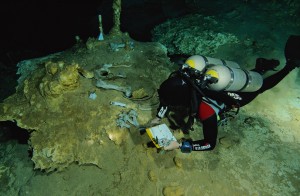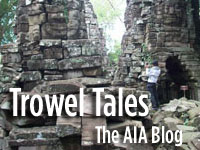Fear and Loathing in the Underworld
by Heather Pringle
November 21, 2008
 Last week an Associated Press reporter wrote a sensational story about a journey he took with Mexican archaeologist Guillermo de Anda through the mythical Maya underworld, Xibalba.  De Anda, a researcher at the University of Yucatán, had pored over the testimony of Maya prisoners accused of heresy in colonial Inquisition courts and collected names of the sacred caves of the Maya. His team then began exploring them. South of Merida, at Tzibichen Cenote, they  found a series of subterranean caves containing a 100-yard concrete road, columns, and several chambers that resembled ancient Maya descriptions of the fearsome Xibalba.Â
Last week an Associated Press reporter wrote a sensational story about a journey he took with Mexican archaeologist Guillermo de Anda through the mythical Maya underworld, Xibalba.  De Anda, a researcher at the University of Yucatán, had pored over the testimony of Maya prisoners accused of heresy in colonial Inquisition courts and collected names of the sacred caves of the Maya. His team then began exploring them. South of Merida, at Tzibichen Cenote, they  found a series of subterranean caves containing a 100-yard concrete road, columns, and several chambers that resembled ancient Maya descriptions of the fearsome Xibalba.Â
This is a very cool discovery, but it’s certainly not the first time that archaeologists have found sacred caves that the Maya regarded as portals to the underworld. (Researchers have recorded several others in former Maya kingdoms.)  Still, I doubt that any of these other finds sparked such fevered journalistic prose.  “There, in the stygian darkness,†wrote the AP reporter of de Anda’s find,  “a scene unfolded that was eerily reminiscent of an “Indiana Jones†movie—tottering ancient temple platforms, slippery staircases and tortuous paths that skirted underground lakes littered with Maya pottery and ancient skulls.† Perhaps there’s some truth buried in that description, but I get very wary every time a journalist conjures up a Indiana Jones movie to describe a site.  Â
In the meantime, another story about Mesoamerica’s remarkable cenotes went all but unnoticed by the press this week. In Dubai, the Rolex corporation bestowed one of its prestigious Awards for Enterprise on a Mexican archaeologist, Arturo González , for his nearly decade-long research in the Yucatán’s dangerous flooded cenotes and subterranean tunnels.   Â
González, the director of the Museum of the Desert in Saltillo, is not looking for vestiges of the Maya: he is searching for something much older and, in my view, potentially more interesting:  the remains of Ice-Age humans.  To date, González and his team of 20 archaeologists and photographers have discovered the fossil skeletons of four humans, one of which has been radiocarbon-dated by three labs to more than 11,600 years ago—the end of the last Ice Age.  This makes it a contender  for the oldest known human skeleton in the Americas.  In addition, González and his colleagues have recovered fossil bones from Ice-Age animals, ranging from giant armadillos to an extinct species from the camel family.Â
During the Ice Age, the sea level was nearly 300 feet lower than it is today, and González believes that early humans camped from time to time in the cenotes and buried their dead in the deepest caves, where few large scavengers would venture. But there is a huge amount that we don’t know. Who were these people? Where did they come from? When did their ancestors arrive in the New World? And by what route? Â
González hopes that his research in the Yucatán’s flooded cenotes will eventually furnish us with at least some answers. But it is hellishly dangerous work. He and his crew frequently take six-hour-long underwater expeditions to the deepest cenotes, and there is very little room for diver error in the mazelike tunnels.  Like others on his team, Gonzalez has found himself wedged tight in narrow, black passageways, unable to move in any direction until he finally summoned up the mental clarity to think his way out. “It’s the strongest panic I’ve ever felt in my life,†he told one interviewer. “It’s indescribable.â€
That’s not the stuff of a Stephen Spielberg film—with tottering temples, chambers lined with snakes and scorpions,  and vine-festooned ruins. That’s the reality of a small group of very determined archaeologists. Â
 Photo courtesy of Rolex/Kurt Amsler  Â
Comments posted here do not represent the views or policies of the Archaeological Institute of America.






 Heather Pringle is a freelance science journalist who has been writing about archaeology for more than 20 years. She is the author of Master Plan: Himmler's Scholars and the Holocaust and The Mummy Congress: Science, Obsession, and the Everlasting Dead. For more about Heather, see our
Heather Pringle is a freelance science journalist who has been writing about archaeology for more than 20 years. She is the author of Master Plan: Himmler's Scholars and the Holocaust and The Mummy Congress: Science, Obsession, and the Everlasting Dead. For more about Heather, see our 



